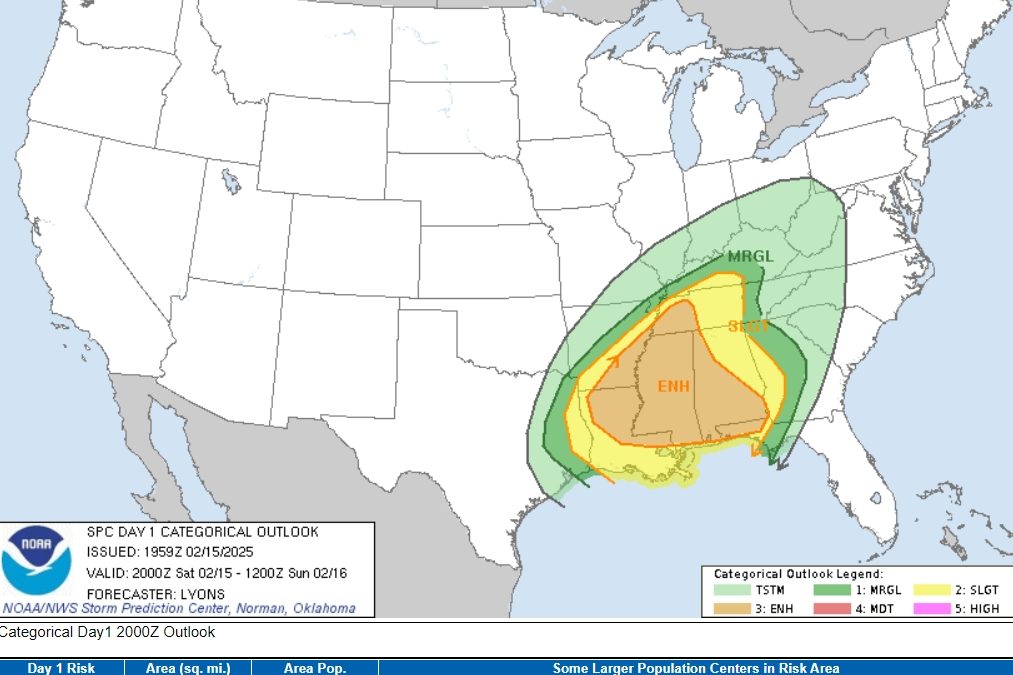I have updated my article to discuss what makes this storm system interesting.
I find it interesting how storms will evolve throughout the day and into the night, including the potential for tornadoes in the Southeast.
- Storm Timing: The severe weather is expected to begin in the afternoon and continue into the night. This is important because nighttime tornadoes are especially dangerous since people are sleeping and might not hear warnings.
- Tornado Risk: While scattered severe storms are possible, the most concerning part is that some tornadoes could be strong (EF2 or higher). These are the kind that can cause significant damage.
- How the Storms Will Change: Early in the day, storms might be scattered and not too intense. But as the system moves east, storms will organize into a powerful squall line—a long, continuous line of severe storms that can bring widespread damaging winds and spin-up tornadoes.
- Dangerous Wind Gusts: The Storm Prediction Center highlights “scattered to numerous damaging wind gusts,” which means a lot of areas could see strong, potentially destructive winds as the storms move through.
- Gulf Coast Overnight Threat: While the storms may weaken in some areas, places like southern Alabama and the Florida Panhandle could see stronger storms late at night. This is because warm, unstable air from the Gulf of Mexico might fuel more storms even after midnight.
Why This Matters
The weather can change quickly. What starts as scattered storms in the afternoon could become a more widespread and intense severe weather outbreak by evening.
Be alert, even after dark. Severe weather at night is harder to see and react to, so people in the affected areas should have weather alerts on their phones and be ready to take cover.
Expect a mix of threats. It’s not just tornadoes; damaging winds and even large hail could also be a problem.
Severe Weather Forecast Explanation – February 14, 2025
Overview
A significant severe weather event is expected across parts of the South, mainly affecting East Texas, Northern Louisiana, Southern Arkansas, Mississippi, and parts of Tennessee and Alabama. The biggest threats will be damaging winds, large hail, and the potential for tornadoes. Storms are expected to develop in the late afternoon and last into the overnight hours.
Breaking It Down: What This Means for You
Regions at Risk
- The most serious threat is in Eastern Texas, Northern Louisiana, Southern Arkansas, and Mississippi (marked in orange/yellow on the map).
- Other areas, including Tennessee and Alabama, could also see strong storms but with a slightly lower risk.
Timing of the Storms
- Storms will begin forming in the late afternoon and evening in Texas and Louisiana.
- By evening into the overnight hours, storms will track east into Mississippi, Alabama, and Tennessee.
Specific Threats
- Tornadoes – Some storms could produce tornadoes, especially in Mississippi, Louisiana, and Arkansas.
- Damaging Winds – Strong winds over 60+ mph could bring down trees and power lines.
- Large Hail – Some areas, particularly in Mississippi and Louisiana, could see hail the size of golf balls or larger.
Why Is This Happening?
A powerful weather system is moving in from the west. As it approaches, it will bring:
- Warm, humid air from the Gulf of Mexico helps fuel storms.
- Strong upper-level winds help organize the storms and increase the tornado threat.
- A cold front will push storms eastward and could cause them to intensify.
Key Takeaways
- If you’re in the affected area, especially Mississippi, Louisiana, Arkansas, and parts of Texas, you should be prepared for severe weather later in the day and overnight.
- Stay updated – Severe weather can change quickly, and tornado watches or warnings may be issued.
- Have a safety plan – Know where to go if a tornado warning is issued (a basement or interior room is best).
- Charge devices & prepare for power outages due to strong winds.
Check out the link above from the Storm Prediction Center for additional information.
If you ever need a weather expert witness for litigation, you can contact one here

